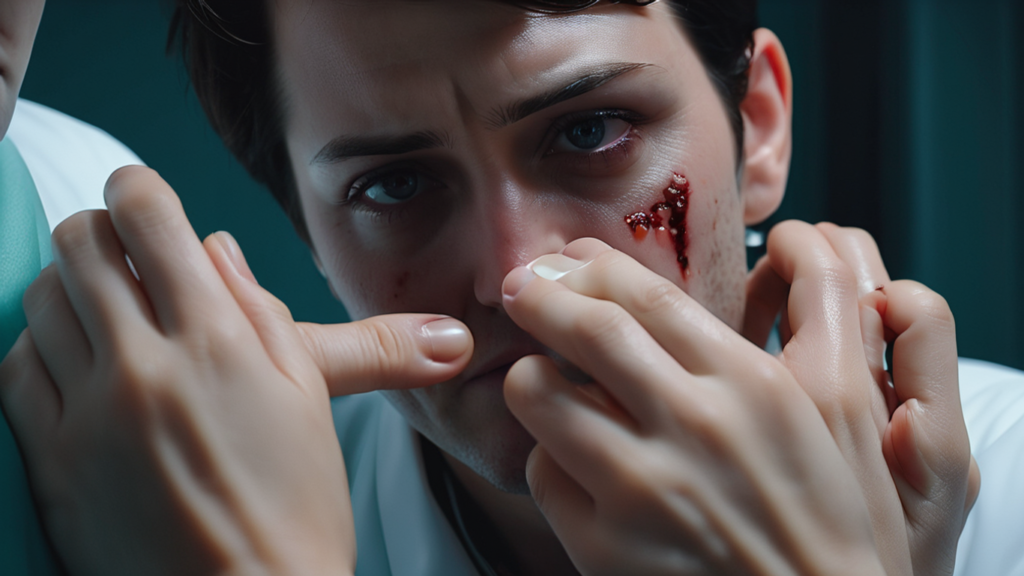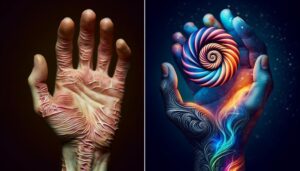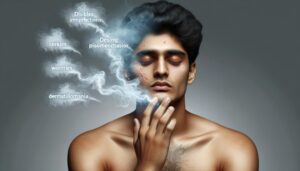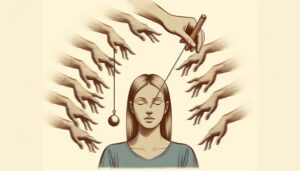
Using Hypnosis for Compulsive Skin Picking
Compulsive skin picking, a condition often linked with anxiety and OCD, presents a significant challenge for conventional treatment methods. In our quest for effective interventions, hypnosis has emerged, offering a novel approach that targets the subconscious drivers of this behavior.
Preliminary research suggests that hypnosis may not only reduce the frequency of skin picking but also enhance overall emotional well-being. However, issues concerning cost and the practicality of post-hypnosis maintenance should be considered.
In the following discussion, we will unpack the potential of hypnosis as a therapeutic tool in managing compulsive skin picking.

Key Takeaways
- Hypnotherapy targets subconscious triggers of Compulsive Skin Picking (CSP), increasing awareness and control.
- Hypnosis, alongside Exposure and Response Prevention, can reduce anxiety and CSP episodes.
- Tailored hypnosis sessions have shown significant improvements in CSP behavior and emotional wellness.
- Self-hypnosis techniques and professional hypnotherapy are effective strategies for managing CSP.
Understanding Compulsive Skin Picking
Delving into the realm of Compulsive Skin Picking (CSP), this condition is a repetitive and damaging behavior akin to Obsessive Compulsive Disorder (OCD), affecting approximately 2-4% of students and dermatology patients. CSP is characterized by the uncontrollable urge to pick at one’s skin, leading to discomfort, pain, and often, visible scarring. The compulsion to pick is usually triggered by stress and anxiety, making it a maladaptive coping mechanism for many individuals.
Treatment for CSP often involves habit reversal training, a cognitive-behavioral technique that teaches patients to recognize the urge to pick and replace it with a less harmful action. However, this method may not be sufficient for everyone. Recent studies have shown the effectiveness of hypnosis in managing CSP. Hypnotherapy can address the underlying psychological drivers of the behavior, helping individuals gain control over their compulsions. By focusing on the subconscious, hypnosis allows for deeper exploration of the triggers and emotions connected to skin picking, leading to a more comprehensive and lasting solution.
Despite CSP’s challenging nature, treatments like hypnosis offer hope for individuals struggling with this condition. It’s crucial to remember that overcoming CSP requires a personalized approach, considering the individual’s unique patterns of behavior and emotional context.
Symptoms and Impact of CSP
 Unraveling the symptoms and impact of Compulsive Skin Picking (CSP) reveals a stark image of physical discomfort and emotional distress, deeply affecting individuals’ daily lives and overall well-being. This obsessive-compulsive behavior, also known as excoriation skin picking, is characterized by an irresistible urge to pick at one’s skin, leading to visible wounds, scarring, and in severe cases, bleeding. The physical repercussions are often accompanied by emotional turmoil, including feelings of shame, self-consciousness, and low self-esteem.
Unraveling the symptoms and impact of Compulsive Skin Picking (CSP) reveals a stark image of physical discomfort and emotional distress, deeply affecting individuals’ daily lives and overall well-being. This obsessive-compulsive behavior, also known as excoriation skin picking, is characterized by an irresistible urge to pick at one’s skin, leading to visible wounds, scarring, and in severe cases, bleeding. The physical repercussions are often accompanied by emotional turmoil, including feelings of shame, self-consciousness, and low self-esteem.
Using Hypnosis for Compulsive Skin Picking
CSP does not discriminate, starting typically between ages 11 and 13, and can persist into adulthood if left untreated. Over time, this can negatively impact personal relationships, professional life, and overall quality of life. Sufferers often experience cycles of severity, with periods of intense skin picking followed by times of respite. This cyclical pattern can make CSP incredibly difficult to manage without professional training or intervention.
The prevalence of CSP, being three times more common than anorexia, underscores its significant impact. However, its classification as a Body Focused Repetitive Behavior, distinct from self-harm, highlights the complex nature of this disorder and the necessity for targeted treatments.
The Role of Anxiety and OCD
How does the intersection of anxiety and Obsessive-Compulsive Disorder (OCD) amplify the struggle with Compulsive Skin Picking (CSP)? Anxiety disorders and OCD often co-occur with CSP, exacerbating the severity of the habit and complicating treatment outcomes.
The intertwining of these conditions is characterized by:
- A high prevalence of CSP in those with anxiety disorders and OCD, affecting around a quarter of these patients.
- Anxiety and stress frequently trigger skin picking episodes, making CSP a maladaptive coping mechanism.
- In OCD patients, the severity of skin picking can lead to significant physical damage and social anxiety.
- Exposure and Response Prevention (ERP), a common treatment for OCD, can be effective in resisting skin picking compulsions.
- Hypnotherapy can complement ERP in managing CSP by reducing anxiety levels and disrupting the compulsive cycle.
Thus, it’s clear that anxiety and OCD play a significant role in CSP, not only in its manifestation but also its treatment. Understanding this dynamic can help in tailoring more effective therapeutic approaches, such as combining ERP with hypnotherapy.
Traditional Treatments for Skin Picking
 Often, traditional treatments for skin picking encompass a variety of approaches, including cognitive behavioral therapy, medication, and psychotherapy, to effectively manage and mitigate this compulsive behavior. Cognitive behavioral therapy, particularly habit reversal training, is a common technique helping individuals resist the urge to pick their skin. It focuses on recognizing the urge, substituting a different response, and implementing this response in a deeply relaxed state.
Often, traditional treatments for skin picking encompass a variety of approaches, including cognitive behavioral therapy, medication, and psychotherapy, to effectively manage and mitigate this compulsive behavior. Cognitive behavioral therapy, particularly habit reversal training, is a common technique helping individuals resist the urge to pick their skin. It focuses on recognizing the urge, substituting a different response, and implementing this response in a deeply relaxed state.
Medications like Selective Serotonin Reuptake Inhibitors (SSRIs) may also be prescribed to manage associated anxiety or OCD symptoms, thus helping to stop the skin picking. Psychotherapy can further contribute by addressing emotional triggers and underlying issues related to this behavior.
Dermatologists may also recommend specific skincare routines to improve skin condition and reduce the need to pick. While each of these traditional treatments can be effective, the results vary based on individual responses and the severity of the condition. Hypnosis makes you become more aware of your subconscious urges, providing another avenue for intervention. However, its role and effectiveness as a treatment option will be discussed in the next section.
Hypnosis as a Treatment Option
Despite the varied success of traditional treatments, an alternative option that has shown promise in addressing compulsive skin picking is hypnosis. Hypnotherapy goes beyond the surface, targeting the subconscious mind to alter the behavior patterns associated with skin picking. This approach fosters increased awareness of triggers and minimizes stress, a common precursor to skin picking episodes.
 Hypnosis treatment has shown encouraging results in patients struggling with compulsive skin picking, who have reported significant progress and improvement in emotional well-being. This is achieved through various mechanisms, such as:
Hypnosis treatment has shown encouraging results in patients struggling with compulsive skin picking, who have reported significant progress and improvement in emotional well-being. This is achieved through various mechanisms, such as:
- Increasing consciousness about picking behaviors
- Identifying and managing triggers like stress and anxiety
- Addressing the underlying emotional factors fueling the habit
- A holistic approach to treatment, focusing on overall stress and anxiety management
- Inducing a state of deep relaxation conducive to promoting positive responses
Incorporating regular hypnosis sessions into a treatment plan may lead to long-term management of skin picking. However, considerations such as cost and the availability of post-session recordings should be factored into the decision. Despite these considerations, hypnosis remains a viable treatment option for compulsive skin picking.
How Hypnosis Addresses Bad Habits
 Delving into the intricacies of hypnotherapy, it becomes evident that this unique approach focuses on the subconscious mind, bolstering awareness of destructive habits such as skin picking and nail biting. By targeting the subconscious, hypnosis aims to increase the individual’s understanding of their compulsive behaviors, thus fostering a deeper mindfulness of their actions.
Delving into the intricacies of hypnotherapy, it becomes evident that this unique approach focuses on the subconscious mind, bolstering awareness of destructive habits such as skin picking and nail biting. By targeting the subconscious, hypnosis aims to increase the individual’s understanding of their compulsive behaviors, thus fostering a deeper mindfulness of their actions.
Hypnosis helps in breaking bad habits by inducing a state of deep relaxation, effectively reducing anxiety levels. This tranquil state allows for the exploration of the triggers that provoke such habits. Once these triggers are identified, hypnosis aids in replacing negative behaviors with positive responses.
Moreover, hypnosis has been found to complement Exposure and Response Prevention (ERP), a cognitive-behavioral technique often used in managing compulsive behaviors like skin picking. By addressing the underlying psychological factors, hypnosis not only helps to curb the physical act of skin picking but also works to resolve the related emotional issues.
In essence, hypnosis provides a comprehensive approach to habit management, offering a promising alternative for those struggling with compulsive skin picking. Its effectiveness, however, may vary depending on the individual’s receptiveness and commitment to the process.
The Process of Hypnotherapy
The journey into the realm of hypnotherapy begins with targeting the subconscious mind, a crucial step in increasing the individual’s awareness of compulsive skin picking behaviors. This process involves a deep dive into the psyche, unearthing triggers and patterns that may be influencing the hand reaching towards the skin, often unnoticed.
Hypnotherapy follows a well-structured process:
- It starts with inducing a state of relaxation, enabling the patient to access their subconscious mind.
- The therapist then introduces self-hypnosis techniques, providing the individual with tools to control their skin picking impulses.
- Interventions are made to transform the skin picking hand into a soothing mechanism, addressing the underlying triggers.
- The patient is guided to recognize associated actions like teeth grinding, further increasing their self-awareness.
- In some cases, regression therapy is used to trace back the origins of the skin picking behavior.
Through this comprehensive approach, hypnotherapy aims to not only alleviate the physical act of skin picking but also address the psychological elements contributing to the habit. It’s a journey of self-discovery, confronting the subconscious mind to achieve lasting behavioral change.
Success Rates of Hypnosis Treatment
Examining the efficacy of hypnosis treatment reveals encouraging success rates in curbing compulsive skin picking, with research demonstrating significant improvements in both behavior and emotional well-being. Hypnosis, by addressing subconscious needs for control and perfectionism, can significantly reduce skin picking behavior.
Studies indicate that hypnosis, when augmented with other therapies, can greatly enhance management of this compulsive disorder. Tailored hypnosis sessions specifically targeting skin picking habits lead to decreased episodes and improved emotional wellness. This is particularly crucial in managing underlying triggers and reducing the urge to pick, providing a level of control previously unattainable for many.
The success of hypnosis treatment is further underscored by positive patient reports. Many individuals have noticed a reduced severity in their picking behavior post-hypnosis, resulting in enhanced impulse control. Some have even adopted additional preventative measures and can now go without concealer, reflecting their newfound confidence.
While cost and the need for regular sessions may be considered barriers, the promising success rates cannot be ignored. Ultimately, hypnosis offers a viable treatment option for compulsive skin pickers seeking to regain control over their actions.
Self-Hypnosis Techniques for CSP
Building on the potential of hypnosis as a treatment for compulsive skin picking, self-hypnosis techniques offer an empowering avenue for individuals to address their own behaviors. This approach could serve as a valuable adjunct to professional behavioral therapy, providing an accessible tool for individuals to manage their compulsions.
Self-hypnosis techniques for CSP can enhance one’s mindfulness, allowing individuals to become more aware of their skin picking triggers. This increased self-awareness, coupled with practical stress reduction methods, can significantly decrease the frequency of skin picking episodes.
Here are some key points to consider about self-hypnosis:
- It can be a powerful tool for self-empowerment, enabling individuals to address their skin picking habits directly.
- By fostering mindfulness, self-hypnosis can help individuals identify and navigate their triggers effectively.
- It provides access to relaxation and stress reduction techniques, which can be used in moments of high anxiety or compulsion.
- Through self-hypnosis, individuals can learn to replace skin picking habits with healthier responses.
- Self-hypnosis can complement professional hypnotherapy sessions, providing a comprehensive approach to managing CSP.
Finding a Qualified Hypnotherapist
 Navigating the path to recovery from compulsive skin picking can be significantly facilitated by the expertise of a qualified hypnotherapist. These professionals can customize hypnosis sessions to effectively target your specific compulsive behaviors, helping you to stop skin picking.
Navigating the path to recovery from compulsive skin picking can be significantly facilitated by the expertise of a qualified hypnotherapist. These professionals can customize hypnosis sessions to effectively target your specific compulsive behaviors, helping you to stop skin picking.
Finding a skilled hypnotherapist is essential. Look for practitioners with a proven track record in treating compulsive behaviors. They should be able to demonstrate their experience and success in helping individuals overcome their skin picking habits.
A qualified hypnotherapist can provide personalized guidance, helping you address the root causes of your compulsive behaviors. They can assist in developing coping strategies, replacing negative habits with positive responses, and strengthening your psychological resilience.
Working with a qualified hypnotherapist can significantly enhance the effectiveness of hypnosis in managing compulsive skin picking. Continual sessions may be beneficial for long-term management, though considerations like cost and post-session follow-up should be taken into account.
Frequently Asked Questions
How Do You Fix Compulsive Skin Picking?
Compulsive skin picking, or dermatillomania, is a psychiatric disorder that can be addressed through various treatment options. Cognitive-behavioral therapy (CBT) is often effective, helping individuals identify triggers and develop healthier coping mechanisms.
Medications, including SSRIs, can also help by managing underlying issues such as anxiety or depression. In severe cases, physical barriers or distraction techniques may be employed.
It’s important to seek professional help to determine the most suitable treatment plan.
How Can I Satisfy My Skin Picking Urge?
To satisfy the urge to pick skin, one can adopt various strategies like cognitive behavioral therapy, maintaining a healthy skincare routine, and finding alternative activities to keep hands busy.
However, it’s crucial to remember that these are just mitigating strategies and professional help should be sought for a comprehensive treatment plan.
This can include psychological therapy and, in some cases, medication to manage the underlying causes such as anxiety or obsessive-compulsive disorder.
Is Skin Picking ADHD or Anxiety?
Skin picking, or Excoriation Disorder, is often linked to anxiety disorders, Obsessive-Compulsive Disorder (OCD), and Body Dysmorphic Disorder (BDD), rather than Attention Deficit Hyperactivity Disorder (ADHD).
It tends to be a coping mechanism for managing stress and anxiety. Treatment usually focuses on addressing these underlying issues, using various therapeutic interventions.
Hypnosis has shown potential in addressing the subconscious drivers of this behavior, resulting in reduced skin picking and improved emotional well-being.
Make an Appointment
 Do not be afraid to reach out to me, Mark E Wilkins, to assist you in any issues you might have. Most Hypnotherapy sessions last 2 hours and EFT Sessions are usually handled with one session. Life Coaching is 45 minute session, one a week. Self-Hypnosis is taught in one session, and lasts a lifetime.
Do not be afraid to reach out to me, Mark E Wilkins, to assist you in any issues you might have. Most Hypnotherapy sessions last 2 hours and EFT Sessions are usually handled with one session. Life Coaching is 45 minute session, one a week. Self-Hypnosis is taught in one session, and lasts a lifetime.
To make an appointment, first listen to the Pre-talk and fill out he Complementary Healthcare Provider Disclosure. The use the Contact Form to request an appointment with the Bohol Hypnosis Expert.
Self help downloads are available. The self hypnosis program to teach you how to self hypnotize is here.
Conclusion
In conclusion, hypnosis presents an innovative approach to managing compulsive skin picking, addressing underlying issues and offering marked improvements.
While deliberations surrounding costs and post-session commitments are imperative, the potential benefits of this non-traditional method are undeniable.
Even with objections regarding accessibility and affordability, the substantial success rates, coupled with the possibility of self-hypnosis techniques, make this a promising avenue deserving further exploration in the quest for effective treatment strategies for compulsive skin picking.


